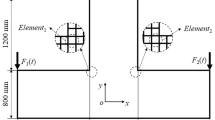Abstract
Choosing an optimal sequence from the set of all possible combinations of a weld’s sub-passes is always a challenge for designers. The solution of such combinatorial optimization problems is limited by the available resources. For example, having n sub-passes leads to choosing from 2n × n! possible combinations of the sub-passes, e.g., 46,080 for n = 6. It is not feasible to choose the optimal sequence by evaluating all possible combinations either experimentally or by simulation models. The purpose of using a surrogate model based on a simulation model is to find the solution in the space of all possible combinations with a significant decrease in computational expenses. In effect, the surrogate model constructs an approximation model from some combinations of solutions of a more expensive model to mimic the behavior of the simulation model as closely as possible but at a much lower computational cost. This surrogate model, then, could be used to approximate the behavior of the other combinations. In this paper, a surrogate model is demonstrated that minimizes the distortion in a pipe girth weld with six sub-passes by analyzing only 14 combinations of sub-passes from total of 48 possible combinations. A comparison between the results of the surrogate model and the full transient FEM analysis all possible combinations shows the accuracy of the algorithm/model.


















Similar content being viewed by others
References
Asadi, M., Goldak, J., Nielsen, J., Zhou, J., Tchernov, S., Downey, D.: Analysis of predicted residual stress in a weld and comparison with experimental data using regression model. Int. J. Mech. Mater. Des. 5(4), 353–364 (2009). doi:10.1007/s10999-009-9107-5
Goldak Technology Inc.: http://www.goldaktec.com/vrweld.html (April 2010)
Goldak, J.A., Chakravarti, A., Bibby, M.J.: A New Finite Element Model for Welding Heat Sources. Trans. AIME. 15B, 299–305 (1984)
Jones, D., Schonlau, M., Welch, W.: Efficient global optimization of expensive black box functions. J. Glob. Optim. 13, 455492 (1998)
Karlsson, L., Pahkamaa, A., Karlberg, M., Lofstrand, M., Goldak, J., Pavasson, J.: Mechanics of materials and structures—a simulation-driven design approach. Under review to be published. (2010)
Pahkamaa, A., Karlsson, L., Pavasson, J., Karlberg, M., Nasstrom, M., Goldak, J.: A method to improve efficiency in welding simulation for simulation driven design. In: International Design Engineering Technical Conference and Computers and Information in Engineering , ASME Conference, DETC2010-28664, August 15–18, 2010, Montreal, Quebec, Canada (2010)
Simo, J.C.: Numerical analysis of classical plasticity. In: Ciarlet, P.G., Lions, J.J. (eds) , Handbook for Numerical Analysis, vol. IV, Elsevier, Amsterdam (1998)
The Lincoln Electric Co. http://www.lincolnelectric.com/knowledge/articles/content/distortion.asp (April 2010)
Voutchkov, I., Keane, A., Bhaskar, A., Olsen, T.: Weld sequence optimization: the use of surrogate models for solving sequential combinatorial problems. Comput. Methods Appl. Mech. Eng. 194(30–33), 3535–3551 (2005)
Wikipedia the Free Encyclopedia: http://en.wikipedia.org/wiki/Surrogate-model (April 2010)
Zienkiewicz, O., Taylor, R.: The Finite Element Method, 4ht edn., vol. 2. McGraw-Hill, London (1989)
Acknowledgements
The authors wish to acknowledge technical supports from Daniel Downy, Stainslav Tchernov and Jianguo Zhou from Goldak Technologies Inc.
Author information
Authors and Affiliations
Corresponding author
Rights and permissions
About this article
Cite this article
Asadi, M., Goldak, J.A. Combinatorial optimization of weld sequence by using a surrogate model to mitigate a weld distortion. Int J Mech Mater Des 7, 123–139 (2011). https://doi.org/10.1007/s10999-011-9154-6
Received:
Accepted:
Published:
Issue Date:
DOI: https://doi.org/10.1007/s10999-011-9154-6




